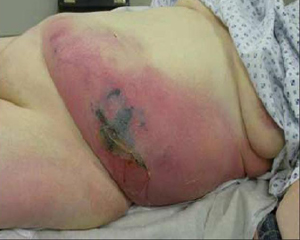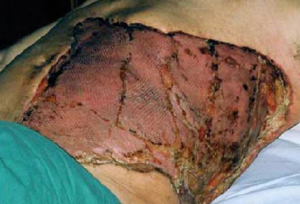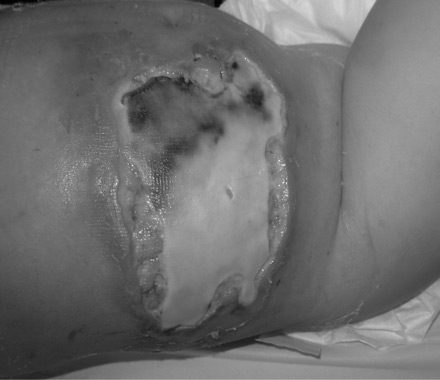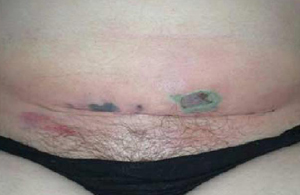Early recognition is important as disease progression is typically rapid. Necrotizing fasciitis is a life-threatening and time-critical surgical emergency.[2]Sartelli M, Guirao X, Hardcastle TC, et al. 2018 WSES/SIS-E consensus conference: recommendations for the management of skin and soft-tissue infections. World J Emerg Surg. 2018 Dec 14;13:58.
https://wjes.biomedcentral.com/articles/10.1186/s13017-018-0219-9
http://www.ncbi.nlm.nih.gov/pubmed/30564282?tool=bestpractice.com
[4]Diab J, Bannan A, Pollitt T. Necrotising fasciitis. BMJ. 2020 Apr 27;369:m1428. Sepsis and multi-organ failure may be present.[2]Sartelli M, Guirao X, Hardcastle TC, et al. 2018 WSES/SIS-E consensus conference: recommendations for the management of skin and soft-tissue infections. World J Emerg Surg. 2018 Dec 14;13:58.
https://wjes.biomedcentral.com/articles/10.1186/s13017-018-0219-9
http://www.ncbi.nlm.nih.gov/pubmed/30564282?tool=bestpractice.com
[35]Bonne SL, Kadri SS. Evaluation and management of necrotizing soft tissue infections. Infect Dis Clin North Am. 2017 Sep;31(3):497-511.
http://www.ncbi.nlm.nih.gov/pubmed/28779832?tool=bestpractice.com
Prompt referral to the surgical team and discussion with critical care is essential. Despite the need for laboratory testing including microbiologic testing and imaging when possible, necrotizing fasciitis remains primarily a clinical diagnosis with signs and symptoms that change rapidly over time.[2]Sartelli M, Guirao X, Hardcastle TC, et al. 2018 WSES/SIS-E consensus conference: recommendations for the management of skin and soft-tissue infections. World J Emerg Surg. 2018 Dec 14;13:58.
https://wjes.biomedcentral.com/articles/10.1186/s13017-018-0219-9
http://www.ncbi.nlm.nih.gov/pubmed/30564282?tool=bestpractice.com
[4]Diab J, Bannan A, Pollitt T. Necrotising fasciitis. BMJ. 2020 Apr 27;369:m1428.
History
The speed of symptom progression should be determined. Inquire for specific risk factors such as:
Preceding skin lesions or breakdown
Trauma, surgery
Immunosuppression due to chronic illness (e.g., diabetes mellitus, alcohol dependence)
Intravenous drug use
Chickenpox
Herpes zoster
It is important to remember that the inciting insult may be minor (e.g., an insect bite) or not recalled by the patient.[1]Pasternack MS, Swartz MN. Cellulitis, necrotizing fasciitis, and subcutaneous tissue infections. In: Bennett JE, Dolin R, Blaser MJ, eds. Mandell, Douglas, and Bennett’s principles and practice of infectious diseases. Philadelphia, PA: Elsevier; 2015:1194-215.[25]Stevens DL, Aldape MJ, Bryant AE. Necrotizing fasciitis, gas gangrene, myositis and myonecrosis. In: Cohen J, Powderly WG, Opal SM, eds. Infectious diseases. Amsterdam, Netherlands: Elsevier; 2017:95-103.e1. Exposure history may occasionally be helpful (e.g., freshwater exposure associated with Aeromonas hydrophila, saltwater exposure or consumption of raw oysters associated with Vibrio vulnificus); however, initial empiric antibiotic selection should be broad and not guided solely by historical exposures.[9]Kuo YL, Shieh SJ, Chiu HY, et al. Necrotizing fasciitis caused by Vibrio vulnificus: epidemiology, clinical findings, treatment and prevention. Eur J Clin Microbiol Infect Dis. 2007 Nov;26(11):785-92.
http://www.ncbi.nlm.nih.gov/pubmed/17674061?tool=bestpractice.com
[15]Hua C, Urbina T, Bosc R, et al. Necrotising soft-tissue infections. Lancet Infect Dis. 2023 Mar;23(3):e81-94.
http://www.ncbi.nlm.nih.gov/pubmed/36252579?tool=bestpractice.com
[25]Stevens DL, Aldape MJ, Bryant AE. Necrotizing fasciitis, gas gangrene, myositis and myonecrosis. In: Cohen J, Powderly WG, Opal SM, eds. Infectious diseases. Amsterdam, Netherlands: Elsevier; 2017:95-103.e1.
Other possible symptoms or signs of necrotizing fasciitis in a patient with cellulitis include lightheadedness, palpitations, nausea or vomiting, or delirium.
Physical exam
The diagnosis should be considered in a patient with cellulitis and clinical warning signs such as a positive quick Sepsis-Related Organ Failure Assessment (qSOFA; not specifically validated for necrotizing fasciitis). Altered mental status (Glasgow Coma Scale ≤15), systolic hypotension (systolic BP ≤100 mmHg), and elevated respiratory rate (≥ 22 bpm) suggest that a patient with cellulitis may have a necrotizing process requiring expedited surgical evaluation.[2]Sartelli M, Guirao X, Hardcastle TC, et al. 2018 WSES/SIS-E consensus conference: recommendations for the management of skin and soft-tissue infections. World J Emerg Surg. 2018 Dec 14;13:58.
https://wjes.biomedcentral.com/articles/10.1186/s13017-018-0219-9
http://www.ncbi.nlm.nih.gov/pubmed/30564282?tool=bestpractice.com
However, the patient may present with nonspecific or nonlocalized symptoms (e.g., acutely unwell with a normal temperature) or there may be severe signs with evidence of multi-organ dysfunction and shock.[2]Sartelli M, Guirao X, Hardcastle TC, et al. 2018 WSES/SIS-E consensus conference: recommendations for the management of skin and soft-tissue infections. World J Emerg Surg. 2018 Dec 14;13:58.
https://wjes.biomedcentral.com/articles/10.1186/s13017-018-0219-9
http://www.ncbi.nlm.nih.gov/pubmed/30564282?tool=bestpractice.com
Anesthesia or severe pain over the site of cellulitis may be clues to an underlying subcutaneous infection.[1]Pasternack MS, Swartz MN. Cellulitis, necrotizing fasciitis, and subcutaneous tissue infections. In: Bennett JE, Dolin R, Blaser MJ, eds. Mandell, Douglas, and Bennett’s principles and practice of infectious diseases. Philadelphia, PA: Elsevier; 2015:1194-215.[16]Hasham S, Matteucci P, Stanley PR, et al. Necrotising fasciitis. BMJ. 2005 Apr 9;330(7495):830-3. [Erratum in: BMJ. 2005 May 14;330(7500):1143].
http://www.ncbi.nlm.nih.gov/pubmed/15817551?tool=bestpractice.com
[19]Cheung JP, Fung B, Tang WM, et al. A review of necrotising fasciitis in the extremities. Hong Kong Med J. 2009 Feb;15(1):44-52.
http://www.hkmj.org/system/files/hkm0902p44.pdf
http://www.ncbi.nlm.nih.gov/pubmed/19197096?tool=bestpractice.com
[20]Angoules AG, Kontakis G, Drakoulakis E, et al. Necrotising fasciitis of upper and lower limb: a systematic review. Injury. 2007 Dec;38(suppl 5):S19-26.
http://www.ncbi.nlm.nih.gov/pubmed/18048033?tool=bestpractice.com
[36]Endorf FW, Cancio LC, Klein MB. Necrotizing soft-tissue infections: clinical guidelines. J Burn Care Res. 2009 Sep-Oct;30(5):769-75.
http://www.ncbi.nlm.nih.gov/pubmed/19692912?tool=bestpractice.com
The pain experienced with necrotizing fasciitis may be disproportionate to the visible skin changes. It should be noted that patients with necrotizing fasciitis can present with normal overlying skin, and that skin changes overlying group A streptococcal necrotizing fasciitis are a late sign.
Exam of the skin overlying the area of cellulitis may reveal crepitus, vesicles, bullae, grayish discoloration, or edema extending beyond erythema.[3]Sartelli M, Coccolini F, Kluger Y, et al. WSES/GAIS/WSIS/SIS-E/AAST global clinical pathways for patients with skin and soft tissue infections. World J Emerg Surg. 2022 Jan 15;17(1):3.
https://wjes.biomedcentral.com/articles/10.1186/s13017-022-00406-2
http://www.ncbi.nlm.nih.gov/pubmed/35033131?tool=bestpractice.com
Subtle skin changes such as leakage of fluid and edema precede the overt skin changes of blistering and redness.
About half of cases occur in the extremities, with the remainder concentrated in the perineum, trunk, and head and neck areas.[1]Pasternack MS, Swartz MN. Cellulitis, necrotizing fasciitis, and subcutaneous tissue infections. In: Bennett JE, Dolin R, Blaser MJ, eds. Mandell, Douglas, and Bennett’s principles and practice of infectious diseases. Philadelphia, PA: Elsevier; 2015:1194-215.[2]Sartelli M, Guirao X, Hardcastle TC, et al. 2018 WSES/SIS-E consensus conference: recommendations for the management of skin and soft-tissue infections. World J Emerg Surg. 2018 Dec 14;13:58.
https://wjes.biomedcentral.com/articles/10.1186/s13017-018-0219-9
http://www.ncbi.nlm.nih.gov/pubmed/30564282?tool=bestpractice.com
[3]Sartelli M, Coccolini F, Kluger Y, et al. WSES/GAIS/WSIS/SIS-E/AAST global clinical pathways for patients with skin and soft tissue infections. World J Emerg Surg. 2022 Jan 15;17(1):3.
https://wjes.biomedcentral.com/articles/10.1186/s13017-022-00406-2
http://www.ncbi.nlm.nih.gov/pubmed/35033131?tool=bestpractice.com
[4]Diab J, Bannan A, Pollitt T. Necrotising fasciitis. BMJ. 2020 Apr 27;369:m1428.[16]Hasham S, Matteucci P, Stanley PR, et al. Necrotising fasciitis. BMJ. 2005 Apr 9;330(7495):830-3. [Erratum in: BMJ. 2005 May 14;330(7500):1143].
http://www.ncbi.nlm.nih.gov/pubmed/15817551?tool=bestpractice.com
[19]Cheung JP, Fung B, Tang WM, et al. A review of necrotising fasciitis in the extremities. Hong Kong Med J. 2009 Feb;15(1):44-52.
http://www.hkmj.org/system/files/hkm0902p44.pdf
http://www.ncbi.nlm.nih.gov/pubmed/19197096?tool=bestpractice.com
[20]Angoules AG, Kontakis G, Drakoulakis E, et al. Necrotising fasciitis of upper and lower limb: a systematic review. Injury. 2007 Dec;38(suppl 5):S19-26.
http://www.ncbi.nlm.nih.gov/pubmed/18048033?tool=bestpractice.com
The most common site of group A streptococcal necrotizing fasciitis is the thigh and necrotizing fasciitis of a limb, especially the arm, is more likely to be due to group A streptococci than a polymicrobial infection. Some cases of necrotizing fasciitis may have associated myositis due to contiguous spread. This is more common in group A streptococcal than polymicrobial infections.
Necrotizing fasciitis in the context of recent abdominal surgery or in the groin is most likely to be polymicrobial.
Laboratory evaluation
All patients admitted with suspected necrotizing fasciitis should have a complete blood count with white cell differential, blood urea nitrogen (BUN), electrolytes, creatinine, and C-reactive protein (CRP) measured urgently. Some of these biomarkers are used for predictive scores including the Laboratory Risk Indicator for Necrotizing Fasciitis (LRINEC). Raised lactate and procalcitonin may also be associated with increased likelihood of morbidity and mortality.[15]Hua C, Urbina T, Bosc R, et al. Necrotising soft-tissue infections. Lancet Infect Dis. 2023 Mar;23(3):e81-94.
http://www.ncbi.nlm.nih.gov/pubmed/36252579?tool=bestpractice.com
Arterial blood gases may be obtained if there is concern for respiratory compromise.
Necrotizing fasciitis is frequently associated with a range of nonspecific laboratory abnormalities including:
Abnormally high or low white blood cell (WBC) count with or without a left shift (elevated percentage of polymorphonuclear leukocytes and/or bands). A low WBC count may be a sign of severe sepsis
Elevated BUN and creatinine due to intracellular volume depletion
Decreased serum sodium
Elevated CRP
Elevated serum creatine kinase
Elevated plasma lactate.
Blood cultures should be obtained before starting antibiotics, and may help identify the causative organism.[15]Hua C, Urbina T, Bosc R, et al. Necrotising soft-tissue infections. Lancet Infect Dis. 2023 Mar;23(3):e81-94.
http://www.ncbi.nlm.nih.gov/pubmed/36252579?tool=bestpractice.com
Gram stain and cultures from needle aspiration or deep tissue cultures obtained during surgical debridement or exploration may also yield a bacteriologic diagnosis.[5]Stevens DL, Bisno AL, Chambers HF, et al. Practice guidelines for the diagnosis and management of skin and soft tissue infections: 2014 update by the Infectious Diseases Society of America. Clin Infect Dis. 2014 Jul 15;59(2):e10-52.
https://academic.oup.com/cid/article/59/2/e10/2895845
http://www.ncbi.nlm.nih.gov/pubmed/24973422?tool=bestpractice.com
[15]Hua C, Urbina T, Bosc R, et al. Necrotising soft-tissue infections. Lancet Infect Dis. 2023 Mar;23(3):e81-94.
http://www.ncbi.nlm.nih.gov/pubmed/36252579?tool=bestpractice.com
Superficial skin swabs should be avoided.[15]Hua C, Urbina T, Bosc R, et al. Necrotising soft-tissue infections. Lancet Infect Dis. 2023 Mar;23(3):e81-94.
http://www.ncbi.nlm.nih.gov/pubmed/36252579?tool=bestpractice.com
Molecular testing and next generation sequencing when available can help identify additional pathogens.[15]Hua C, Urbina T, Bosc R, et al. Necrotising soft-tissue infections. Lancet Infect Dis. 2023 Mar;23(3):e81-94.
http://www.ncbi.nlm.nih.gov/pubmed/36252579?tool=bestpractice.com
Imaging
Imaging studies should not delay surgical intervention when diagnosis is clinically suspected.[2]Sartelli M, Guirao X, Hardcastle TC, et al. 2018 WSES/SIS-E consensus conference: recommendations for the management of skin and soft-tissue infections. World J Emerg Surg. 2018 Dec 14;13:58.
https://wjes.biomedcentral.com/articles/10.1186/s13017-018-0219-9
http://www.ncbi.nlm.nih.gov/pubmed/30564282?tool=bestpractice.com
[3]Sartelli M, Coccolini F, Kluger Y, et al. WSES/GAIS/WSIS/SIS-E/AAST global clinical pathways for patients with skin and soft tissue infections. World J Emerg Surg. 2022 Jan 15;17(1):3.
https://wjes.biomedcentral.com/articles/10.1186/s13017-022-00406-2
http://www.ncbi.nlm.nih.gov/pubmed/35033131?tool=bestpractice.com
[5]Stevens DL, Bisno AL, Chambers HF, et al. Practice guidelines for the diagnosis and management of skin and soft tissue infections: 2014 update by the Infectious Diseases Society of America. Clin Infect Dis. 2014 Jul 15;59(2):e10-52.
https://academic.oup.com/cid/article/59/2/e10/2895845
http://www.ncbi.nlm.nih.gov/pubmed/24973422?tool=bestpractice.com
[15]Hua C, Urbina T, Bosc R, et al. Necrotising soft-tissue infections. Lancet Infect Dis. 2023 Mar;23(3):e81-94.
http://www.ncbi.nlm.nih.gov/pubmed/36252579?tool=bestpractice.com
In clinically stable patients, radiography may provide supportive evidence for a necrotizing process.
Plain radiography is frequently normal during the early stages; subcutaneous gas may be present as the disease progresses. The diagnosis should be strongly suspected if soft-tissue gas is visualized on radiologic examination, which may also demonstrate abnormalities in the involved soft tissue.[1]Pasternack MS, Swartz MN. Cellulitis, necrotizing fasciitis, and subcutaneous tissue infections. In: Bennett JE, Dolin R, Blaser MJ, eds. Mandell, Douglas, and Bennett’s principles and practice of infectious diseases. Philadelphia, PA: Elsevier; 2015:1194-215.[2]Sartelli M, Guirao X, Hardcastle TC, et al. 2018 WSES/SIS-E consensus conference: recommendations for the management of skin and soft-tissue infections. World J Emerg Surg. 2018 Dec 14;13:58.
https://wjes.biomedcentral.com/articles/10.1186/s13017-018-0219-9
http://www.ncbi.nlm.nih.gov/pubmed/30564282?tool=bestpractice.com
[16]Hasham S, Matteucci P, Stanley PR, et al. Necrotising fasciitis. BMJ. 2005 Apr 9;330(7495):830-3. [Erratum in: BMJ. 2005 May 14;330(7500):1143].
http://www.ncbi.nlm.nih.gov/pubmed/15817551?tool=bestpractice.com
[37]American College of Radiology. ACR appropriateness criteria: suspected osteomyelitis, septic arthritis, or soft tissue infection (excluding spine and diabetic foot). 2022 [internet publication].
https://acsearch.acr.org/docs/3094201/Narrative
However, soft-tissue gas is a late sign, and plain radiography has poor sensitivity for detecting signs of necrotizing infection.[15]Hua C, Urbina T, Bosc R, et al. Necrotising soft-tissue infections. Lancet Infect Dis. 2023 Mar;23(3):e81-94.
http://www.ncbi.nlm.nih.gov/pubmed/36252579?tool=bestpractice.com
Ultrasound may help to differentiate simple cellulitis from necrotizing fasciitis and has the advantage that it can be rapidly performed at bedside.[2]Sartelli M, Guirao X, Hardcastle TC, et al. 2018 WSES/SIS-E consensus conference: recommendations for the management of skin and soft-tissue infections. World J Emerg Surg. 2018 Dec 14;13:58.
https://wjes.biomedcentral.com/articles/10.1186/s13017-018-0219-9
http://www.ncbi.nlm.nih.gov/pubmed/30564282?tool=bestpractice.com
In one prospective study, ultrasound findings of diffuse thickening of the subcutaneous tissue, accompanied by fluid accumulation greater than 4 mm in depth, had a sensitivity of 88% and specificity of 93%.[38]Yen ZS, Wang HP, Ma HM, et al. Ultrasonographic screening of clinically-suspected necrotizing fasciitis. Acad Emerg Med. 2002 Dec;9(12):1448-51.
https://onlinelibrary.wiley.com/doi/abs/10.1197/aemj.9.12.1448?sid=nlm%3Apubmed
http://www.ncbi.nlm.nih.gov/pubmed/12460854?tool=bestpractice.com
Computed tomography (CT) and magnetic resonance imaging (MRI) offer higher sensitivity.[3]Sartelli M, Coccolini F, Kluger Y, et al. WSES/GAIS/WSIS/SIS-E/AAST global clinical pathways for patients with skin and soft tissue infections. World J Emerg Surg. 2022 Jan 15;17(1):3.
https://wjes.biomedcentral.com/articles/10.1186/s13017-022-00406-2
http://www.ncbi.nlm.nih.gov/pubmed/35033131?tool=bestpractice.com
[37]American College of Radiology. ACR appropriateness criteria: suspected osteomyelitis, septic arthritis, or soft tissue infection (excluding spine and diabetic foot). 2022 [internet publication].
https://acsearch.acr.org/docs/3094201/Narrative
CT is indicated in abdominoperineal and cervicofacial infections to show the portal of entry of infection and to guide surgical intervention; for limb or peripheral necrotizing soft-tissue CT is of limited value.[15]Hua C, Urbina T, Bosc R, et al. Necrotising soft-tissue infections. Lancet Infect Dis. 2023 Mar;23(3):e81-94.
http://www.ncbi.nlm.nih.gov/pubmed/36252579?tool=bestpractice.com
[37]American College of Radiology. ACR appropriateness criteria: suspected osteomyelitis, septic arthritis, or soft tissue infection (excluding spine and diabetic foot). 2022 [internet publication].
https://acsearch.acr.org/docs/3094201/Narrative
MRI is more sensitive for assessing necrotizing soft-tissue infections of the limbs, and may show thickening of the fascia, deep fascial fluid, or edema. However, these signs are not specific to necrotizing infection and may be seen in other soft-tissue infections such as cellulitis, and MRI may be difficult to organize in an emergency and is not recommended as the first-line imaging technique.[2]Sartelli M, Guirao X, Hardcastle TC, et al. 2018 WSES/SIS-E consensus conference: recommendations for the management of skin and soft-tissue infections. World J Emerg Surg. 2018 Dec 14;13:58.
https://wjes.biomedcentral.com/articles/10.1186/s13017-018-0219-9
http://www.ncbi.nlm.nih.gov/pubmed/30564282?tool=bestpractice.com
[3]Sartelli M, Coccolini F, Kluger Y, et al. WSES/GAIS/WSIS/SIS-E/AAST global clinical pathways for patients with skin and soft tissue infections. World J Emerg Surg. 2022 Jan 15;17(1):3.
https://wjes.biomedcentral.com/articles/10.1186/s13017-022-00406-2
http://www.ncbi.nlm.nih.gov/pubmed/35033131?tool=bestpractice.com
[15]Hua C, Urbina T, Bosc R, et al. Necrotising soft-tissue infections. Lancet Infect Dis. 2023 Mar;23(3):e81-94.
http://www.ncbi.nlm.nih.gov/pubmed/36252579?tool=bestpractice.com
[39]Gelbard RB, Ferrada P, Yeh DD, et al. Optimal timing of initial debridement for necrotizing soft tissue infection: a practice management guideline from the Eastern Association for the Surgery of Trauma. J Trauma Acute Care Surg. 2018 Jul;85(1):208-14.
http://www.ncbi.nlm.nih.gov/pubmed/29485428?tool=bestpractice.com
In a meta-analysis, CT had sensitivity of 88.5% and specificity of 93.3%, while plain radiography had sensitivity of 48.9% and specificity of 94.0% for diagnosing necrotizing soft-tissue infections.[40]Fernando SM, Tran A, Cheng W, et al. Necrotizing soft tissue infection: diagnostic accuracy of physical examination, imaging, and LRINEC Score: a systematic review and meta-analysis. Ann Surg. 2019 Jan;269(1):58-65.
http://www.ncbi.nlm.nih.gov/pubmed/29672405?tool=bestpractice.com
Early frozen-section soft-tissue biopsy can provide a definitive diagnosis and may be used if the diagnosis is unclear clinically or radiologically.[2]Sartelli M, Guirao X, Hardcastle TC, et al. 2018 WSES/SIS-E consensus conference: recommendations for the management of skin and soft-tissue infections. World J Emerg Surg. 2018 Dec 14;13:58.
https://wjes.biomedcentral.com/articles/10.1186/s13017-018-0219-9
http://www.ncbi.nlm.nih.gov/pubmed/30564282?tool=bestpractice.com
However, frozen-section soft-tissue biopsy requires specialist pathology expertise, takes time to perform, and is not widely available in all regions, including in the UK.[2]Sartelli M, Guirao X, Hardcastle TC, et al. 2018 WSES/SIS-E consensus conference: recommendations for the management of skin and soft-tissue infections. World J Emerg Surg. 2018 Dec 14;13:58.
https://wjes.biomedcentral.com/articles/10.1186/s13017-018-0219-9
http://www.ncbi.nlm.nih.gov/pubmed/30564282?tool=bestpractice.com
Diagnostic criteria
The use of severity assessment scores may be helpful in identifying patients at high risk of systemic sepsis and, therefore, those who need urgent critical care and surgical assessment.[2]Sartelli M, Guirao X, Hardcastle TC, et al. 2018 WSES/SIS-E consensus conference: recommendations for the management of skin and soft-tissue infections. World J Emerg Surg. 2018 Dec 14;13:58.
https://wjes.biomedcentral.com/articles/10.1186/s13017-018-0219-9
http://www.ncbi.nlm.nih.gov/pubmed/30564282?tool=bestpractice.com
Necrotizing fasciitis should be considered in a patient with cellulitis and clinical warning signs such as a positive quick Sepsis-Related Organ Failure Assessment (qSOFA; for use in settings other than the intensive care unit). However, no studies have specifically addressed the use of qSOFA, or the Sequential Organ Failure Assessment (SOFA; for use in the intensive care unit), in necrotizing fasciitis.
The LRINEC scoring system, based upon laboratory abnormalities (CRP, hemoglobin sodium, creatinine, glucose), has been developed in an attempt to assist with early discrimination of necrotizing fasciitis from less severe skin and soft-tissue infections.[3]Sartelli M, Coccolini F, Kluger Y, et al. WSES/GAIS/WSIS/SIS-E/AAST global clinical pathways for patients with skin and soft tissue infections. World J Emerg Surg. 2022 Jan 15;17(1):3.
https://wjes.biomedcentral.com/articles/10.1186/s13017-022-00406-2
http://www.ncbi.nlm.nih.gov/pubmed/35033131?tool=bestpractice.com
[41]Wong CH, Khin LW, Heng KS, et al. The LRINEC (Laboratory Risk Indicator for Necrotizing Fasciitis) score: a tool for distinguishing necrotizing fasciitis from other soft tissue infections. Crit Care Med. 2004 Jul;32(7):1535-41.
http://www.ncbi.nlm.nih.gov/pubmed/15241098?tool=bestpractice.com
In a 2019 meta-analysis, a LRINEC 6 was associated with a sensitivity of 68.2% (95% CI 51.4% to 81.3%) and specificity of 84.8% (95% CI 75.8% to 90.9%) for diagnosis of necrotizing soft-tissue infections.[40]Fernando SM, Tran A, Cheng W, et al. Necrotizing soft tissue infection: diagnostic accuracy of physical examination, imaging, and LRINEC Score: a systematic review and meta-analysis. Ann Surg. 2019 Jan;269(1):58-65.
http://www.ncbi.nlm.nih.gov/pubmed/29672405?tool=bestpractice.com
While validation studies have failed to demonstrate sufficient sensitivity or specificity to either diagnose or exclude necrotizing fasciitis, a higher LRINEC score on presentation has been associated with a higher risk of mortality in necrotizing fasciitis.[40]Fernando SM, Tran A, Cheng W, et al. Necrotizing soft tissue infection: diagnostic accuracy of physical examination, imaging, and LRINEC Score: a systematic review and meta-analysis. Ann Surg. 2019 Jan;269(1):58-65.
http://www.ncbi.nlm.nih.gov/pubmed/29672405?tool=bestpractice.com
[42]Hsiao CT, Chang CP, Huang TY, et al. Prospective validation of the Laboratory Risk Indicator for Necrotizing Fasciitis (LRINEC) Score for necrotizing fasciitis of the extremities. PLoS One. 2020 Jan 24;15(1):e0227748.
https://journals.plos.org/plosone/article?id=10.1371/journal.pone.0227748
http://www.ncbi.nlm.nih.gov/pubmed/31978094?tool=bestpractice.com
[43]Hoesl V, Kempa S, Prantl L, et al. The LRINEC score-an indicator for the course and prognosis of necrotizing fasciitis? J Clin Med. 2022 Jun 22;11(13):3583.
https://www.mdpi.com/2077-0383/11/13/3583
http://www.ncbi.nlm.nih.gov/pubmed/35806870?tool=bestpractice.com
Consultation
Involving a range of experts with a multidisciplinary approach may improve management and prognosis, along with a high index of suspicion for the condition.[15]Hua C, Urbina T, Bosc R, et al. Necrotising soft-tissue infections. Lancet Infect Dis. 2023 Mar;23(3):e81-94.
http://www.ncbi.nlm.nih.gov/pubmed/36252579?tool=bestpractice.com
Senior decision makers should be involved early when necrotizing fasciitis is suspected, given that there is a low incidence and poor sensitivity of early clinical signs and in the absence of optimal noninvasive diagnostic tools.[15]Hua C, Urbina T, Bosc R, et al. Necrotising soft-tissue infections. Lancet Infect Dis. 2023 Mar;23(3):e81-94.
http://www.ncbi.nlm.nih.gov/pubmed/36252579?tool=bestpractice.com
An urgent surgical consultation for inspection, exploration, and debridement of infected tissue should be obtained as soon as the diagnosis is suspected.[3]Sartelli M, Coccolini F, Kluger Y, et al. WSES/GAIS/WSIS/SIS-E/AAST global clinical pathways for patients with skin and soft tissue infections. World J Emerg Surg. 2022 Jan 15;17(1):3.
https://wjes.biomedcentral.com/articles/10.1186/s13017-022-00406-2
http://www.ncbi.nlm.nih.gov/pubmed/35033131?tool=bestpractice.com
Additional early consultations include involving an intensive care specialist.[15]Hua C, Urbina T, Bosc R, et al. Necrotising soft-tissue infections. Lancet Infect Dis. 2023 Mar;23(3):e81-94.
http://www.ncbi.nlm.nih.gov/pubmed/36252579?tool=bestpractice.com
Definitive bacteriologic diagnosis is best made from tissue specimens obtained from surgical debridement.[5]Stevens DL, Bisno AL, Chambers HF, et al. Practice guidelines for the diagnosis and management of skin and soft tissue infections: 2014 update by the Infectious Diseases Society of America. Clin Infect Dis. 2014 Jul 15;59(2):e10-52.
https://academic.oup.com/cid/article/59/2/e10/2895845
http://www.ncbi.nlm.nih.gov/pubmed/24973422?tool=bestpractice.com
Staining of clinically affected tissue may provide an early indication of the causative organism(s). For example, small chains of gram-positive cocci suggest a streptococcal infection, whereas clumps of large cocci suggest Staphylococcus aureus. Culture growth of blood or tissue specimens identifies a bacterial cause. The infection may be monomicrobial or polymicrobial.[1]Pasternack MS, Swartz MN. Cellulitis, necrotizing fasciitis, and subcutaneous tissue infections. In: Bennett JE, Dolin R, Blaser MJ, eds. Mandell, Douglas, and Bennett’s principles and practice of infectious diseases. Philadelphia, PA: Elsevier; 2015:1194-215.[5]Stevens DL, Bisno AL, Chambers HF, et al. Practice guidelines for the diagnosis and management of skin and soft tissue infections: 2014 update by the Infectious Diseases Society of America. Clin Infect Dis. 2014 Jul 15;59(2):e10-52.
https://academic.oup.com/cid/article/59/2/e10/2895845
http://www.ncbi.nlm.nih.gov/pubmed/24973422?tool=bestpractice.com
[16]Hasham S, Matteucci P, Stanley PR, et al. Necrotising fasciitis. BMJ. 2005 Apr 9;330(7495):830-3. [Erratum in: BMJ. 2005 May 14;330(7500):1143].
http://www.ncbi.nlm.nih.gov/pubmed/15817551?tool=bestpractice.com
[19]Cheung JP, Fung B, Tang WM, et al. A review of necrotising fasciitis in the extremities. Hong Kong Med J. 2009 Feb;15(1):44-52.
http://www.hkmj.org/system/files/hkm0902p44.pdf
http://www.ncbi.nlm.nih.gov/pubmed/19197096?tool=bestpractice.com
[20]Angoules AG, Kontakis G, Drakoulakis E, et al. Necrotising fasciitis of upper and lower limb: a systematic review. Injury. 2007 Dec;38(suppl 5):S19-26.
http://www.ncbi.nlm.nih.gov/pubmed/18048033?tool=bestpractice.com
[Figure caption and citation for the preceding image starts]: Late signs of necrotizing fasciitis with extensive cellulitis, induration, skin necrosis, and formation of hemorrhagic bullaeFrom: Hasham S, Matteucci P, Stanley PRW, et al. Necrotising fasciitis. BMJ. 2005 Apr 9;330(7495):830-3 [Citation ends]. [Figure caption and citation for the preceding image starts]: Split thickness skin grafting after surgical debridementFrom: Hasham S, Matteucci P, Stanley PRW, et al. Necrotising fasciitis. BMJ. 2005 Apr 9;330(7495):830-3 [Citation ends].
[Figure caption and citation for the preceding image starts]: Split thickness skin grafting after surgical debridementFrom: Hasham S, Matteucci P, Stanley PRW, et al. Necrotising fasciitis. BMJ. 2005 Apr 9;330(7495):830-3 [Citation ends]. [Figure caption and citation for the preceding image starts]: Necrotizing fasciitis on the right abdomen of a 2-year old girl following varicella infectionFrom: de Benedictis FM, Osimani P. Necrotising fasciitis complicating varicella. BMJ Case Rep. 2009;2009:bcr2008141994 [Citation ends].
[Figure caption and citation for the preceding image starts]: Necrotizing fasciitis on the right abdomen of a 2-year old girl following varicella infectionFrom: de Benedictis FM, Osimani P. Necrotising fasciitis complicating varicella. BMJ Case Rep. 2009;2009:bcr2008141994 [Citation ends].
[Figure caption and citation for the preceding image starts]: Small areas of skin necrosis in a young woman with cellulitis and necrotizing fasciitis of her lower abdomen 5 days after a cesarean sectionFrom: Hasham S, Matteucci P, Stanley PRW, et al. Necrotising fasciitis. BMJ. 2005 Apr 9;330(7495):830-3 [Citation ends].
Consultation with an infectious disease expert to assist with empiric antibiotic regimen, as well as subsequent appropriate de-escalation of therapy, is highly recommended.[15]Hua C, Urbina T, Bosc R, et al. Necrotising soft-tissue infections. Lancet Infect Dis. 2023 Mar;23(3):e81-94.
http://www.ncbi.nlm.nih.gov/pubmed/36252579?tool=bestpractice.com
 [Figure caption and citation for the preceding image starts]: Split thickness skin grafting after surgical debridementFrom: Hasham S, Matteucci P, Stanley PRW, et al. Necrotising fasciitis. BMJ. 2005 Apr 9;330(7495):830-3 [Citation ends].
[Figure caption and citation for the preceding image starts]: Split thickness skin grafting after surgical debridementFrom: Hasham S, Matteucci P, Stanley PRW, et al. Necrotising fasciitis. BMJ. 2005 Apr 9;330(7495):830-3 [Citation ends]. [Figure caption and citation for the preceding image starts]: Necrotizing fasciitis on the right abdomen of a 2-year old girl following varicella infectionFrom: de Benedictis FM, Osimani P. Necrotising fasciitis complicating varicella. BMJ Case Rep. 2009;2009:bcr2008141994 [Citation ends].
[Figure caption and citation for the preceding image starts]: Necrotizing fasciitis on the right abdomen of a 2-year old girl following varicella infectionFrom: de Benedictis FM, Osimani P. Necrotising fasciitis complicating varicella. BMJ Case Rep. 2009;2009:bcr2008141994 [Citation ends].
